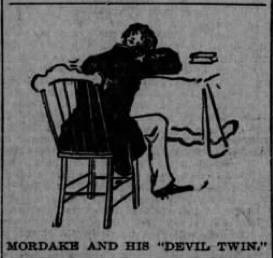Edward Mordake
Edward Mordake (sometimes spelled Mordrake) was purported to be a 19th-century English heir and nobleman who has become a subject of urban legend and folklore. According to the legend, Mordake was born with an extra face on the back of his head. This additional face could neither eat nor speak out loud but was said to whisper horrible things to Mordake at night, driving him to despair and, ultimately, to his untimely death. Despite the captivating nature of his story, there is little historical evidence to support the existence of Edward Mordake, leading many to believe that he was nothing more than a fictional character.
Background[edit | edit source]
The tale of Edward Mordake first appeared in print in an 1895 article by Charles Lotin Hildreth in the Boston Post. The article, titled "The Wonders of Modern Science," presented Mordake as one of the "human freaks" lamented by medical science. Hildreth's account is the primary source of the Mordake legend, and it is likely that the story was a work of fiction presented as fact, a common practice in 19th-century journalism known as yellow journalism.
The Legend[edit | edit source]
According to legend, Edward Mordake was a bright, charming young man, heir to one of the noblest families in England. He was described as having great musical and scholarly talents but was doomed by a second face on the back of his head. This face, a duplicate of his own, was said to possess its own intelligence and to be malignant in nature. It could laugh and cry but was incapable of eating or speaking intelligibly. Mordake reportedly begged doctors to remove his "demon head" because it whispered things that "one would only speak about in hell" at night, but no doctor would attempt it. The legend concludes with Mordake committing suicide at the age of 23.
Medical Perspective[edit | edit source]
The condition described in the Mordake legend resembles a rare congenital disorder known as craniofacial duplication (diprosopus), or less accurately, parasitic twinning. However, these medical conditions do not match the fantastical elements of the Mordake story, such as the second face being sentient and capable of independent thought or speech.
Cultural Impact[edit | edit source]
Edward Mordake has become a figure of fascination within popular culture, inspiring various works of fiction, music, and art. His story is often cited in discussions of medical anomalies and the human fascination with physical deformities. Despite the lack of verifiable evidence of his existence, Mordake's tale continues to be a popular subject for horror and speculative fiction.
Conclusion[edit | edit source]
The story of Edward Mordake, while compelling, is widely regarded as a piece of folklore rather than a documented historical case. The lack of credible evidence and the fantastical elements of the tale suggest that Mordake was a fictional creation, possibly intended as a cautionary tale about the dangers of unchecked scientific curiosity or the burdens of nobility.
Search WikiMD
Ad.Tired of being Overweight? Try W8MD's physician weight loss program.
Semaglutide (Ozempic / Wegovy and Tirzepatide (Mounjaro / Zepbound) available.
Advertise on WikiMD
|
WikiMD's Wellness Encyclopedia |
| Let Food Be Thy Medicine Medicine Thy Food - Hippocrates |
Translate this page: - East Asian
中文,
日本,
한국어,
South Asian
हिन्दी,
தமிழ்,
తెలుగు,
Urdu,
ಕನ್ನಡ,
Southeast Asian
Indonesian,
Vietnamese,
Thai,
မြန်မာဘာသာ,
বাংলা
European
español,
Deutsch,
français,
Greek,
português do Brasil,
polski,
română,
русский,
Nederlands,
norsk,
svenska,
suomi,
Italian
Middle Eastern & African
عربى,
Turkish,
Persian,
Hebrew,
Afrikaans,
isiZulu,
Kiswahili,
Other
Bulgarian,
Hungarian,
Czech,
Swedish,
മലയാളം,
मराठी,
ਪੰਜਾਬੀ,
ગુજરાતી,
Portuguese,
Ukrainian
WikiMD is not a substitute for professional medical advice. See full disclaimer.
Credits:Most images are courtesy of Wikimedia commons, and templates Wikipedia, licensed under CC BY SA or similar.
Contributors: Prab R. Tumpati, MD

